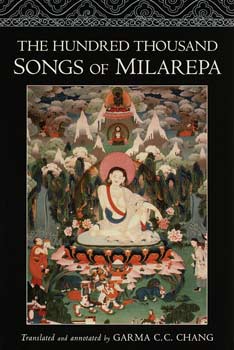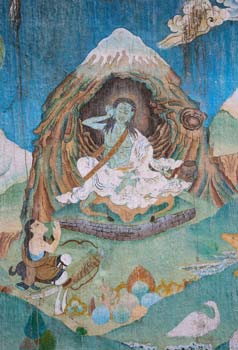Upon the joyful news of his birth, Mila Sharab Gyalten named his newborn son Thopaga, “Delightful to Hear.” This name turned out to be fitting. The child would eventually become one of Tibet’s most beloved poet-saints, known for his beautiful singing voice and inspiring spiritual songs. Many of these poems survived the centuries and continue to delight and instruct spiritual seekers today.
The life story of Tibetan Buddhist Jetsun Milarepa is long and colorful. He was born into a prosperous family in 1052. When Milarepa was seven years old his father died, entrusting the family estate to greedy relatives who usurped the family business and property. Milarepa, his mother, and his sister were cast into severe poverty.
Upon his mother’s insistence, Milarepa left the family village to learn black magic in order to seek revenge against the relatives. He succeeded and returned to cast his evil spells. During a harvest celebration, Milarepa’s magic destroyed his relatives’ and their supporters’ properties. The entire community knew who was responsible. Milarepa’s reputation as a sorcerer continued throughout his life.
Milarepa’s mother was satisfied that vengeance had been served, but a growing guilt took over his own conscience. His belief in karma and the hereafter haunted him. He knew that no matter how justified he’d been in his great destructions, he would have to pay his karmic debt.
Redemption from such karmic debt may be attained with intense spiritual effort under the direct instruction of a master. Knowing this, Milarepa left his mother and sister and set out to find such a master. He was determined to take instruction from Marpa Lotsawa, also called Marpa the Translator. Marpa was a famous Buddhist sage with an impressive lineage.
Milarepa suffered many trials before being accepted by this lama who knew the extent of Milarepa’s karmic debt and the price of its release. Marpa instructed Milarepa to singlehandedly build and then destroy several houses. The last building, nine stories high, still stands today. When Marpa was at last satisfied that Milarepa had repented for his deeds of black magic and had paid his karmic debt, he taught him the traditional Buddhist secrets of enlightenment that he so craved.
From then on, Milarepa continued his spiritual practices in various caves in Tibet. He lived in unimaginable poverty, begging for food and subsisting on whatever nature provided. Illustrations of Milarepa often depict him with green skin because of his survival on nettles.
Although Milarepa achieved his goal of karmic freedom, he continued intense practices throughout his life. He chose a solitary life in caves and forests. Milarepa’s spiritual achievements attracted disciples whose love inspired them to preserve his songs and life story as an inspiration to future seekers.
Keeping Good Company
Following is an excerpt from one of Milarepa’s songs:
“Perseverance is the short road to freedom;
it is the necessary road to all holiness.
He who lacks it is bereft of hope.
A man must mount the steed of perseverance.
No one who has heard and deeply pondered
on the acquiring of merit by the practice of religion
can ever dispense with it.”
Learning a Master’s life story is a small part of keeping good company. Few of us are capable of the intense asceticism practiced by Milarepa. However, anyone can incorporate at least some part of the lessons he taught through his example and teachings.
Of much greater importance are reading, understanding, and assimilating a master’s teachings. Make them an integral part of your own being. It’s not necessary, initially, to grasp every subtlety of a teaching; one’s attitude should include open-mindedness, a willingness to learn, and taking the time to consider and practice.
Yoga is not an “armchair philosophy.” It should be practiced and experienced. This practice will make an indelible impression on your heart and mind. You will grow spiritually by leaps and bounds.
Chityānanda has been a disciple of Svāmī Gurupremānanda Sarasvatī since 1975. She teaches meditation and yoga as a spiritual path in Santa Cruz, California.


I was impressed by the following: “Redemption from such karmic debt can only be attained with intense spiritual effort under the direct instruction of a Buddhist master.” So, it seems that just because we haven’t caused great destruction in this life, we may still have Karma from before. Thus, it follows that when we find our Guru, we should endeavor to persevere in our spiritual practices to free ourselves.
Thank you for your contribution, John. In the Eastern tradition, we believe in the principle of reincarnation–rebirth. In that light, yes, we are always carrying karma from previous lives. The Bhagavad Gita says that karma is very mysterious, and it’s right. We can’t really know how or why our lives are as they are. But we do have control of our present thoughts and actions, so we have some say about our future. That’s the perseverance that you mentioned–good point! Namaste.
Milarepa obeyed implicitly to his Guru’s command and settled in a rock cave stocked with provisions occasionally passed through the aperture. There he remained 11 months meditating on the Truths he received. Master asked him what experiences and insights he gained during his retreat. Milarepa replied,
The first step in his Understanding was the awareness to have a realized Master, keeping faith in him implicitly. On this path is a means to Love and Compassion. Then he meditated deeply on the rarity of human birth, knowing that the mind can be your friend or your enemy. So he said never cease to work on yourself. Meditation is the path to enlightenment. Finally a realized Master alone can explain the Final Goal to the disciple.
Thank you for joining the conversation, Sue! Namaste.
I understand that Milarepa came back in his lifetime, as part of his own karma, to speed a bunch of bad people along their own karmic path. As a result he created additional bad karma for himself. Knowing this, Milarepa, as well as his guru, put himself through “hell” to expunge his bad karma in order to become realized. I was wondering, just wondering, what if just at the brink of becoming realized, he was wiped out, would he come back in his next life as an avatar?? I often wondered how avatars came into being.
Thank you for your comment, Tosh. That’s a lot of speculation there! According to the Bhagavad Gita, avatars come into being when conditions of the world require Divine intervention. Namaste.
My favorite Milarepa poem to date is, “I Have Forgotten.” This poem reveals the secret to living the enlightened life: Whatever is long and lovingly contemplated unseats all contrary notions and perceptions.
Thank you for that reference, Jinpa. I’m sure you have everyone running to their books of Milarepa’s poems to find that one! Namaste.
Dear Svami Chityananda,
It’s mystifying to read about the period of time it takes to subdue all restraining karma complemented by the level of intensity, sincerity, and devotion it takes to remove. Milarepa bore a tremendous amount of karma. For self improvement there is a popular saying that one should “take one step back to take two steps forward.” I often visualize this as a staircase with no beginning or end in sight. Under Milarepa’s circumstance, so it seems, he tripped over his ego and plunged to the bottom of the staircase. In desperation, he sought after Marpa Lotsawa who guided Milarepa. With intense devotion and surrender, Milarepa miraculously lugged himself to the top of the staircase reaching enlightenment within less than a lifetime! All because he followed his master’s orders, Milarepa’s extreme feat was possible.
Thank you for your insights, Trevor. I think it’s such a good lesson for us all–that enlightenment is possible within this very lifetime. It’s a mistake to think it can’t be done. Namaste.
“Perseverance is the short road to freedom; it is the necessary road to all holiness. He who lacks it is bereft of hope. A man must mount the steed of perseverance.” Milarepa
Consistent practice is a challenge for me. I have fits of starts and stops on almost all projects. Recently, I decided to pursue things I value, even if it’s for only 5 or 10 minutes everyday. I’ll see how it works out. But as Milarepa says, I must persevere. Peace, MoeB
Thank you for your contribution here, MoeB. May I offer you some advice? In my own practice, I’ve discovered that the only way to be persistent is to put it first. That means that I must do my practices at the very beginning of each and every day. Once my day begins, even if it’s just a “quick” look at email, my day is lost. So, along with persistent practice, I need the discipline to put my sadhana first. What I’ve discovered is that everything else just falls into place after that. Sincere best wishes!
Good evening Svami Chityananda.
Mila’s karmic debt certainly was heavy. Small wonder his song speaks to persistence.
The Guru Gita also speaks to liberation from lifetimes of karma: “Countless sins of countless births, Hold men tightly to the earth. The only way to free oneself Is by devotion, nothing else.”
Perhaps all Gurus require devoted, loving service in exchange for their Knowledge?
The struggles of Milarepa’s life inspire me…and I am beyond glad my Guru’s practice prescription did not require me to build houses from stones carried on my back.*
—
*I had no idea Mila’s 9 story house was extant. Happily, I found a picture at this weblink: https://goo.gl/images/PmmkYR
Hello, Rob. Thank you for sending the link to images of the tower built by Milarepa’s own hands. Seeing it really gives a sense of his effort. Perhaps if your Guru’s “practice prescription” (nice term) didn’t include such labors, it means you don’t need it. But we all need a little inspiration from time to time, so I’m happy to hear that Milarepa’s story provides that to you. Namaste.
Dear Svami,
I like the way you write. Instead of telling us, your readers, about Masters you also tell us why such reading is good. And your hint: “It’s not necessary, initially, to grasp every subtlety of a teaching…” is very helpful.
Thank you,
Sam.
Thank you for pointing that out, Sam. It gives me the opportunity to say that by repeated study of saints and scriptures, we continue to learn. Living the spiritual life is not like getting a degree where you learn a subject and then put your books away for the rest of your life. We return again and again to our teachings because understanding develops with the time well spent doing spiritual practices like meditation. Namaste.
Dear Svami,
If Milarepa achieved karmic liberation from service and devotion to his master, why did he continue such intense practices for so long after?
Ah, good question, Richard! What comes to mind is Bhagavad Gita 3:21: “However a great man conducts himself, common men will follow. Accordingly, whatever standards he sets by his actions, others will follow in his footsteps.” I can only speculate beyond this. Namaste.
I like Milarepa’s story and his teaching songs very much. Milarepa uses everyday examples in simple language to explain the deepest truths.
Yes, Roxie. I agree, and maybe that’s why we still know about Milarepa after all these years. His stories, songs, and teachings still speak to modern seekers. Namaste.
I certainly hope that I will not have to go through what Milarepa did. I read the book about his life, and Marpa was a very tough Guru. It is good that those who have brought yoga to the west have shown us a less arduous path.
Thank you for your comment, Tim. Since you are familiar with Milarepa’s story, you know that he incurred some pretty nasty karma. He was most fortunate to have a tough Guru who could help him repay his karmic debt and become enlightened in one lifetime. That’s quite an accomplishment! Namaste.